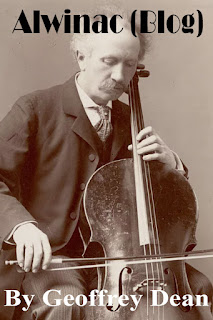 |
| [Click on image to go directly to the Alwinac’s home page] |

My recent post on cello poetry brought to mind the writings of Robert Haven Schauffler, who studied cello with Alwin Schroeder at Princeton University at the turn of the 20th century. The author of numerous books, article, and poems on music and other subjects, Schauffler credited Schroeder for encouraging him to pursue writing professionally. He quoted Schroeder as telling him, “As a cellist you would spend your life playing into the air the music of others. ... But as a writer you might create something yourself that would live after you are gone.” (From R. H. Schauffler letter to Victor Danek, 1955, quoted in Danek, A Historical Study of the Kneisel Quartet [Bloomington: Indiana University, 1962], 197)
Schauffler’s poem “The Music Maker” opens with a tribute to his own cello, made by Gasparo da Salo:
Though but a passing thought in Schauffler’s essay, it wouldn’t be long before Leon Theremin, purported to be a cellist himself, was marketing his electrical instruments through his New York-based Teletouch Co. Patented in 1928, the space-controlled theremin remains the best known, and most often played, of Theremin's electric instruments....
_______________
Read on….
Schauffler’s poem “The Music Maker” opens with a tribute to his own cello, made by Gasparo da Salo:
Beneath the bowIn his 1911 collection of essays on amateur music-making, Schauffler discusses his first tentative steps toward mastering cello technique. In “Fiddler’s Lure” (Schauffler, The Musical Amateur: A Book on the Human Side of Music [Boston: Houghton Mifflin, 1911], 30-55), he describes how, at fifteen, he “chanced upon an old ’cello in the attic” and “fell devoted slave” to it: “A week of furtive practice convinced me that I could play the ’cello, though I now remember grasping the bow like a tennis-racket and the fingerboard like a trolley-strap.” In this essay Schauffler takes the Old King Cole nursery rhyme as his point of departure, arguing that the King himself played the cello in string quartets, with his “fiddlers three.” Discussing the effort and dedication required to play well enough to read Beethoven’s Op. 59 quartets (mentioned specifically in the Old King Cole rhyme), Schauffler imagines a yet-to-be-invented “telo-melo cello,” an electric instrument playable by just the touch of a button, that would remove the toil and struggle of mastering the old-fashioned instrument “with bow in hand.”
Your live cords, ’cello mio, throb and stir,—
My viol-like, dreamful child of Gasparo,—
Raising from reverie your Lombard voice,
And bidding us rejoice,
In all the things of soul and sense that make
These beauty-consecrated chambers glow….
—Schauffler, Selected Poems
(London: Heinemann, 1922), 48
Though but a passing thought in Schauffler’s essay, it wouldn’t be long before Leon Theremin, purported to be a cellist himself, was marketing his electrical instruments through his New York-based Teletouch Co. Patented in 1928, the space-controlled theremin remains the best known, and most often played, of Theremin's electric instruments....
_______________
Read on….
| Copyright © 2022 by Geoffrey Dean |
No comments:
Post a Comment